Cover photo by Gerhard Diedericks.
Find this species in the FBIS database (Freshwater Biodiversity Information System) here.
Family Libellulidae
There are two distinct subspecies of the Julia Skimmer. Orthetrum julia falsum (Julia Skimmer) and Orthetrum julia capicola (Cape Skimmer). Some authorities treat them as separate species. The differences between them are clear enough that they are treated separately here.
Identification
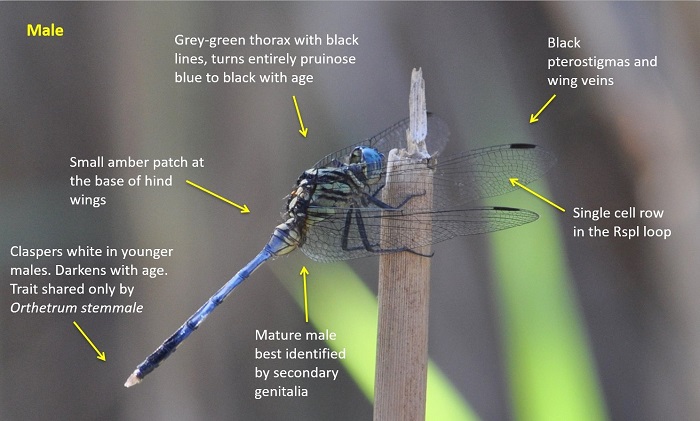
False Bay, iSimangaliso Wetland Park, KwaZulu-Natal
Photo by Ryan Tippett
Medium sized
Length up to 57mm; Wingspan attains 74mm.
The Julia Skimmer is most similar to Orthetrum stemmale (Bold Skimmer) and Orthetrum capicola (Cape Skimmer).
The most reliable way to differentiate between the Julia Skimmer and the Bold Skimmer (Orthetrum stemmale) is by examining the characteristic shapes of the males secondary genitalia. In addition the Julia Skimmer has black, rather than yellowish pterostigmas and all blackish wing venation. The Bold Skimmer has white subcostal Ax-veins. Furthermore Orthetrum julia falsum shows a single cell row in the Rspl loop, whereas Orthetrum stemmale generally has two cell rows in the Rspl loop.
Julia and Cape skimmers (Orthetrum julia capicola) have very similarly shaped secondary genitalia. They can, however, be told apart by other features. Orthetrum julia falsum has blackish pterostigmas and white claspers, while Orthetrum julia capicola shows yellow-brown pterostigmas and dark claspers.
Click here for more details on identification.
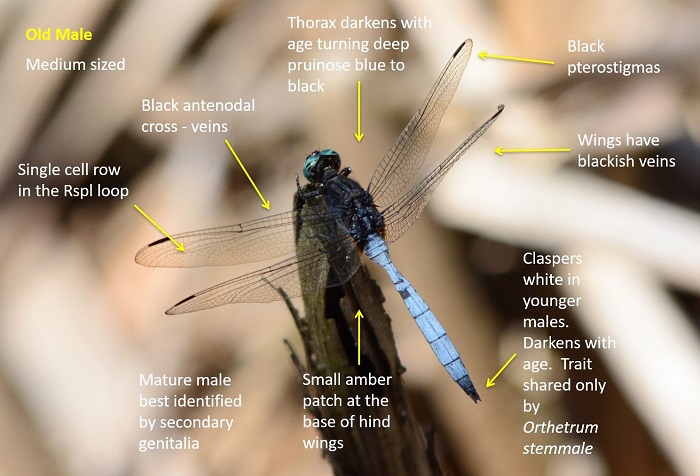
False Bay, iSimangaliso Wetland Park, KwaZulu-Natal
Photo by Ryan Tippett
Habitat
The Julia Skimmer inhabits shaded streams, rivers, pools, and dams in dense forested or wooded areas. It frequents both still and flowing waters, but is regularly found away from water when not breeding.

Photo by Ryan Tippett
Behaviour
Breeding individuals are found on waterside vegetation, but also away from water in the surrounding forest or woodlands. The Julia Skimmer favours shady sites where it sits on exposed twigs in dappled light. It hunts from a perch and often returns to the same spot after each foray.
The Julia Skimmer is on the wing from September to May.
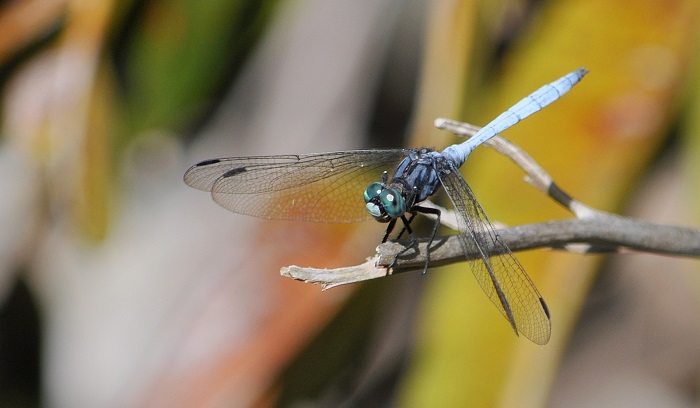
False Bay, iSimangaliso Wetland Park, KwaZulu-Natal
Photo by Ryan Tippett
Status and Conservation
The Julia Skimmer is common across its southern African range. It is listed as of Least Concern in the IUCN Red List of Threatened Species. The Julia Skimmer is highly adaptable and inhabits any suitable habitat, natural or man-made.
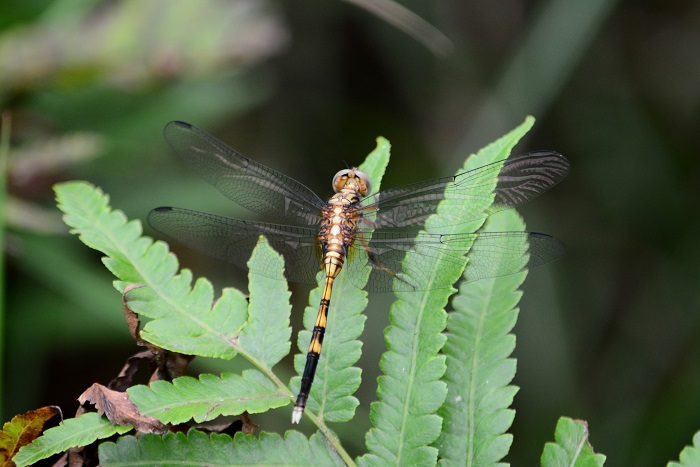
Hluhluwe district, KwaZulu-Natal
Photo by Ryan Tippett
Distribution
The Julia Skimmer is widespread in higher rainfall regions across Sub-Saharan Africa.
In South Africa, the Julia Skimmer is found in the eastern half, where it is most numerous in KwaZulu-Natal, Mpumalanga, Gauteng, and Limpopo.
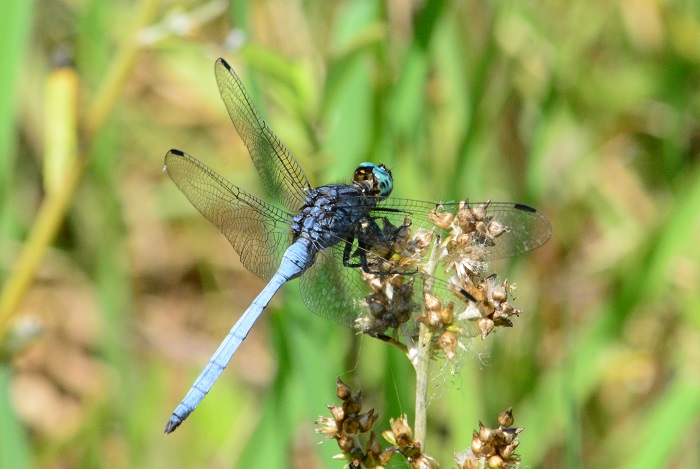
Near iXopo, KwaZulu-Natal
Photo by Ryan Tippett
Below is a map showing the combined distribution records for Julia and Cape Skimmers in the OdonataMAP database as of February 2020.

Below is a map showing the combined distribution records for Julia and Cape Skimmers in the OdonataMAP database as of December 2024.

The next map below is an imputed map, produced by an interpolation algorithm, which attempts to generate a full distribution map from the partial information in the map above. This map will be improved by the submission of records to the OdonataMAP section of the Virtual Museum.


Ultimately, we will produce a series of maps for all the odonata species in the region. The current algorithm is a new algorithm. The objective is mainly to produce “smoothed” maps that could go into a field guide for odonata. This basic version of the algorithm (as mapped above) does not make use of “explanatory variables” (e.g. altitude, terrain roughness, presence of freshwater — we will be producing maps that take these variables into account soon). Currently, it only makes use of the OdonataMAP records for the species being mapped, as well as all the other records of all other species. The basic maps are “optimistic” and will generally show ranges to be larger than what they probably are.
These maps use the data in the OdonataMAP section of the Virtual Museum, and also the database assembled by the previous JRS funded project, which was led by Professor Michael Samways and Dr KD Dijkstra.

False Bay, iSimangaliso Wetland Park, KwaZulu-Natal
Photo by Ryan Tippett
Further Resources
The use of photographs by Gerhard Diedericks. Other photographs by Ryan Tippett.
Julia Skimmer Orthetrum julia falsum Longfield, 1955
Other common names: Julia-skepper (Afrikaans)
Recommended citation format: Loftie-Eaton M; Navarro R; Tippett RM; Underhill L. 2025. Julia Skimmer Orthetrum julia falsum. Biodiversity and Development Institute. Available online at https://thebdi.org/2020/05/18/julia-skimmer-orthetrum-julia-falsum/
References: Tarboton, M; Tarboton, W. (2019). A Guide to the Dragonflies & Damselflies of South Africa. Struik Nature.
Samways, MJ. (2008). Dragonflies and Damselflies of South Africa. Pensoft
Samways, MJ. (2016). Manual of Freshwater Assessment for South Africa: Dragonfly Biotic Index. Suricata 2. South African National Biodiversity Institute, Pretoria
Martens, A; Suhling, F. (2007). Dragonflies and Damselflies of Namibia. Gamsberg Macmillan.
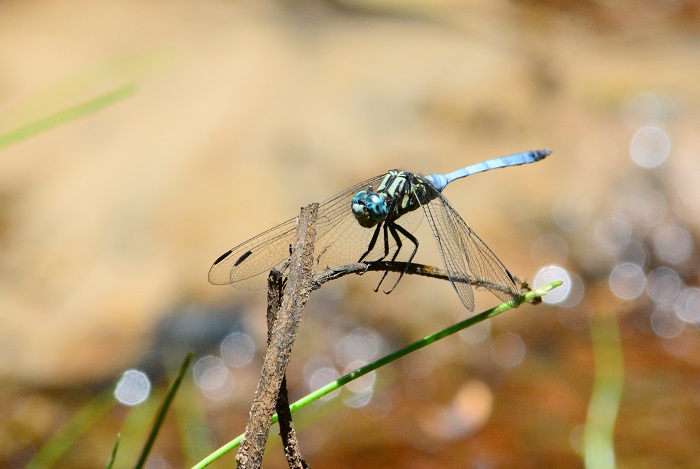
Eastern Shores, iSimangaliso Wetland Park, KwaZulu-Natal
Photo by Ryan Tippett

